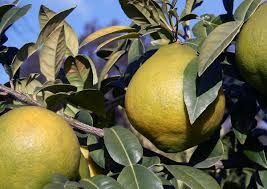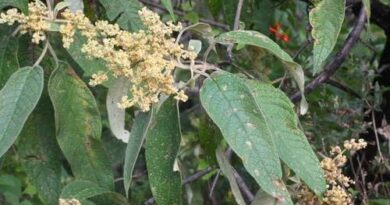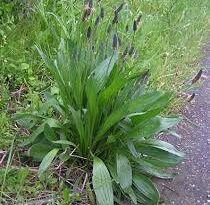10 Medicinal Health Benefits of Vachellia tortilis (Umbrella Thorn Acacia)
Vachellia tortilis, also commonly referred to as the umbrella thorn acacia, is a distinctive and adaptive tree species that belongs to the Fabaceae family. This botanical marvel showcases a remarkable ability to thrive in arid and semi-arid regions, demonstrating its resilience and significance in often harsh environments.
The most prominent feature of this tree is its umbrella-like canopy, which provides essential shade in the scorching African sun. This umbrella shape is formed by the wide-spreading branches that grow horizontally, maximizing the shading effect.
The bark of Vachellia tortilis is rough, fissured, and displays a greyish-brown to dark brown coloration. This robust bark serves as protection against environmental stressors and herbivore activities.
The leaves are compound and bipinnate, giving them a feathery and fern-like appearance. They consist of numerous small leaflets that provide the tree with the ability to minimize water loss through transpiration.
Thorns are a defining feature of the umbrella thorn acacia. These thorns are long, sharp, and often occur in pairs. They serve as a defense mechanism against herbivores, discouraging them from browsing on the foliage.
Vachellia tortilis produces fragrant and small puffball-like flowers. These flowers are pale yellow to cream in color and are densely clustered, creating visually appealing inflorescences.
The tree bears flat and elongated pods that mature from green to brown. These pods contain small, rounded seeds that are encased within a dry, papery covering.
Vachellia tortilis thrives in arid and semi-arid regions of Africa, particularly in the savannas, grasslands, and deserts. It is well-suited to such environments due to its adaptations for water conservation, including its leaf structure and ability to form symbiotic relationships with nitrogen-fixing bacteria.
The wide canopy offers shade to a variety of wildlife, from large mammals to smaller insects, aiding them in surviving the harsh heat. Vachellia tortilis forms symbiotic relationships with nitrogen-fixing bacteria in its root nodules. This process enriches the soil with essential nutrients, benefiting other plants and organisms in the area
The pods of Vachellia tortilis are a valuable food source for many animals, including herbivores and seed-eating birds. The presence of Vachellia tortilis can trigger the development of microhabitats, providing shelter and resources for various species.
Read Also: 15 Medicinal Health Benefits of Curcuma Zanthorrhiza (Temulawak)
The Medicinal Health Benefits of Vachellia tortilis (Umbrella Thorn Acacia)

1. Immune System Boost: Vachellia tortilis is rich in antioxidants, which help bolster the immune system’s defenses against various infections and diseases.
2. Digestive Aid: The tree’s gum, obtained from its bark, has been traditionally used to soothe digestive discomfort and promote healthy digestion.
3. Anti-Inflammatory Properties: Extracts from Vachellia tortilis have shown anti-inflammatory effects, making them valuable for managing conditions like arthritis.
4. Respiratory Relief: Infusions made from the leaves and bark can help alleviate respiratory issues such as coughs and bronchitis.
5. Wound Healing: The gum’s adhesive and healing properties make it beneficial for wound dressing and accelerating the healing process.
6. Antimicrobial Effects: Compounds found in Vachellia tortilis possess antimicrobial properties, aiding in the prevention and treatment of infections.
7. Diuretic Action: The tree’s extracts can act as diuretics, promoting the elimination of toxins and excess fluids from the body.
8. Blood Sugar Regulation: Some studies suggest that Vachellia tortilis may assist in managing blood sugar levels, offering potential benefits for individuals with diabetes.
9. Antioxidant Richness: The plant’s antioxidants help combat oxidative stress, a contributing factor to various chronic diseases.
10. Skin Health: Applications of Vachellia tortilis extracts may contribute to healthier skin by reducing inflammation and enhancing hydration.
Read Also: Wheat Palea: Economic Importance, Uses and By-Products
The Methods of Usage to Achieve the Provided Health Benefits of Vachellia tortilis (Umbrella Thorn Acacia)
1. Gum Infusion: Prepare an infusion by soaking the gum in warm water. This method allows you to consume the infused liquid, which can provide digestive and immune benefits due to the plant’s rich antioxidants and bioactive compounds.
2. Leaf Poultice: Create a poultice by crushing fresh leaves into a paste-like consistency. You can then apply this poultice directly to wounds or skin irritations. The natural antimicrobial and wound-healing properties of the leaves can assist in promoting faster recovery.
3. Bark Extracts: Boil the bark in water to create an extract. This liquid can be used as a wash or compress for addressing respiratory issues and promoting wound healing. The extract’s anti-inflammatory and antiseptic properties can contribute to these benefits.
4. Tea Preparation: Infuse either the leaves or bark in hot water to create a therapeutic tea. Consuming this tea may provide a range of health benefits, including immune support, respiratory relief, and digestive aid. Adjust the strength of the infusion to suit your needs.
5. Topical Ointment: Combine Vachellia tortilis extracts with a suitable carrier oil or base to create a topical ointment. This can be applied to skin concerns like inflammation, rashes, or minor wounds. The ointment’s soothing and moisturizing properties can help alleviate discomfort.
6. Inhalation: For respiratory benefits, you can inhale steam infused with Vachellia tortilis bark. Be cautious during this process to avoid burns. The steam’s aromatic compounds can potentially provide respiratory relief by easing congestion and irritation.
The Side Effects of Using Vachellia tortilis Medicinal Plant
1. Allergic Reactions: Some individuals may be sensitive to the plant’s compounds, leading to allergic reactions such as skin irritation, itching, or hives upon contact.
2. Digestive Discomfort: Excessive consumption of the gum or other parts of the plant may lead to digestive discomfort, including abdominal pain, bloating, or diarrhea.
3. Interaction with Medications: Vachellia tortilis may interact with certain medications, potentially affecting their efficacy or causing adverse effects. Consult a healthcare professional if you are on medication.
4. Photosensitivity: In some cases, contact with Vachellia tortilis or its extracts could increase skin photosensitivity, making the skin more susceptible to sunburn.
5. Respiratory Irritation: Inhaling steam from bark extracts without proper caution can lead to respiratory irritation, causing coughing or discomfort.
6. Hypersensitivity: Individuals with a history of hypersensitivity or allergies to plants within the Fabaceae family should exercise caution when using Vachellia tortilis.
7. Gastrointestinal Upset: Consumption of Vachellia tortilis preparations in excessive amounts may result in gastrointestinal upset, including nausea and vomiting.
8. Blood Sugar Effects: While Vachellia tortilis may help regulate blood sugar levels, individuals with diabetes should monitor their blood sugar closely to prevent unintended fluctuations.
Read Also: How to Make Money from Electronics Recycling (E-waste Recycling)









